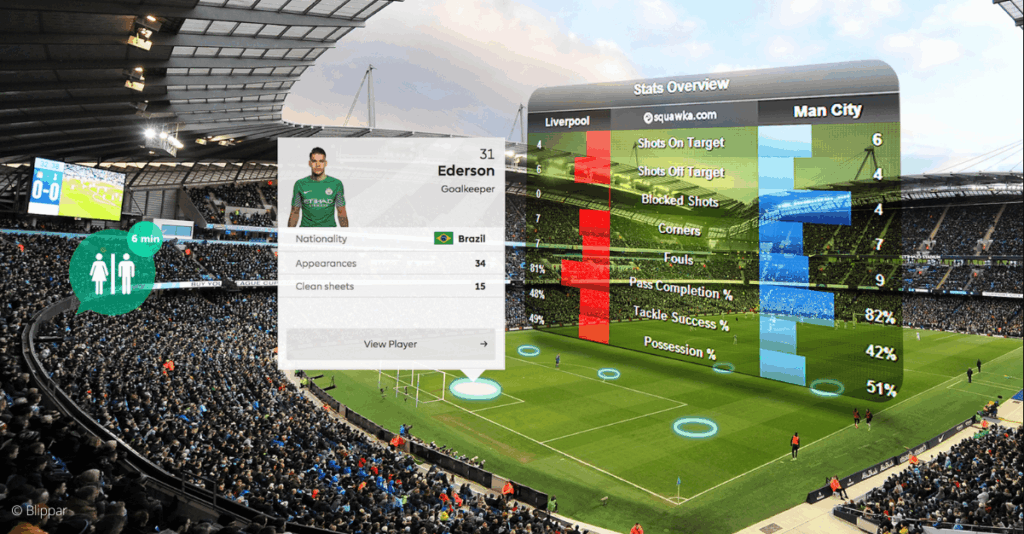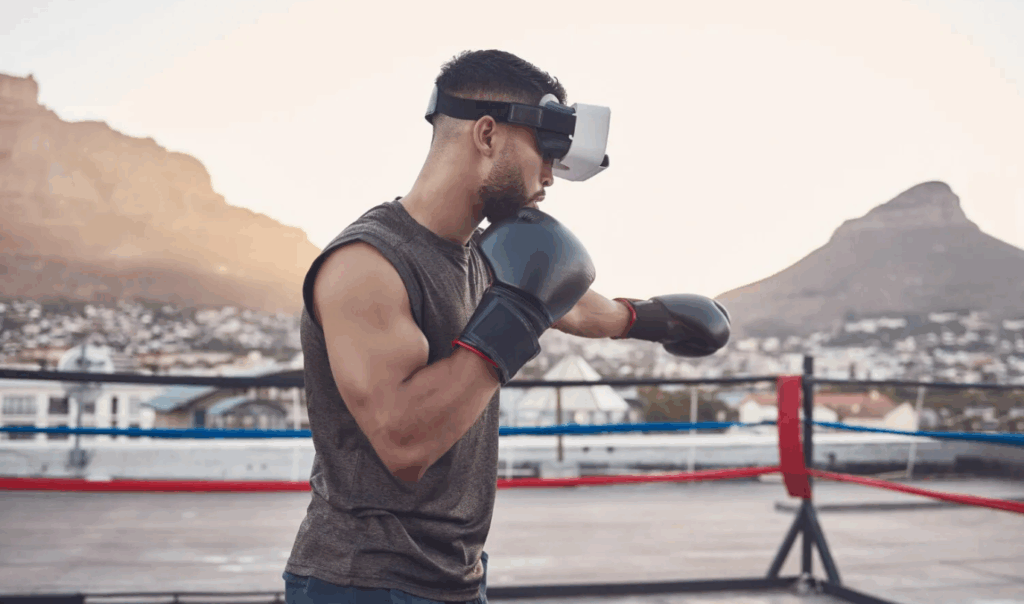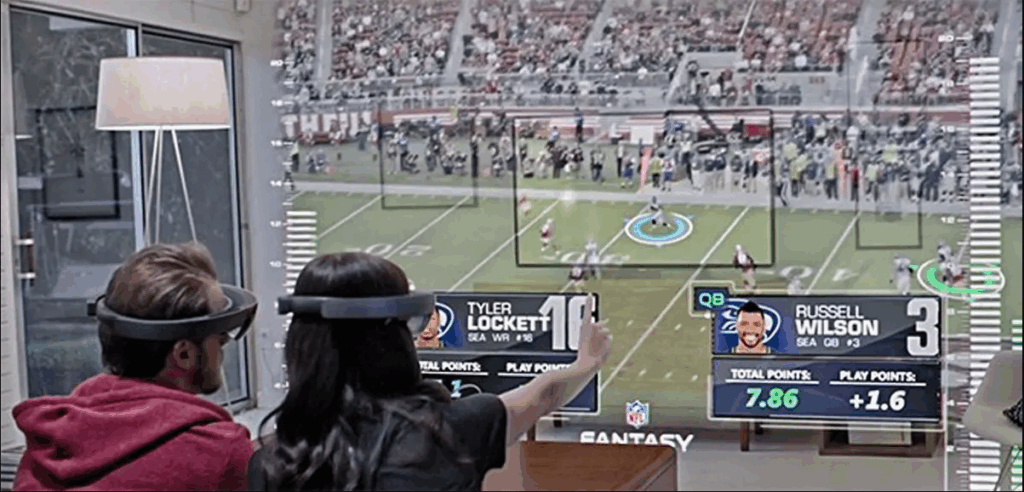You’ve seen athletes wearing headsets during practice and wondered what’s happening behind those lenses. AR and VR are quietly transforming how champions train and coaches strategize. While traditional methods still dominate most fields and courts, a digital revolution is brewing that could make today’s training look primitive. The question isn’t whether you’ll embrace these tools, but how soon they’ll become essential to staying competitive.
Understanding AR and VR in a Sports Context
Ever wondered why your favorite athletes seem to move with superhuman precision? They’re increasingly using virtual reality training and AR for athletes to sharpen their skills. While VR creates fully immersive training environments where you can practice without physical limits, AR overlays digital information onto the real world during actual practice sessions.
Think of VR as stepping into a completely digital basketball court where you can perfect your three-point shot thousands of times. AR, meanwhile, projects real-time data through smart coaching tools onto your field of vision while you’re actually playing.
These athlete tracking systems capture every movement, providing instant feedback that traditional coaching can’t match. You’ll find immersive training revolutionizing everything from quarterback decision-making to gymnastic routines, fundamentally changing how athletes prepare for competition.

Enhanced Training Through Virtual Reality
Now that you understand how these technologies work, let’s explore how VR transforms the way athletes train. You’ll find VR sports simulation creates game-like scenarios without physical risks or travel costs. Players practice plays repeatedly in virtual stadiums, facing different defensive formations and weather conditions.
This next-gen sports training accelerates skill acquisition by letting you perfect movements in controlled environments. You’re not just watching a film anymore. You’re inside it. Quarterbacks throw thousands of passes, batters face endless pitches, and goalkeepers stop penalty kicks from every angle.
Beyond physical skills, VR enhances tactical visualization and mental conditioning. You’ll memorize complex playbooks faster when you’ve experienced them firsthand. The technology also builds confidence by simulating high-pressure moments, preparing your mind for clutch situations before they happen.

Augmented Reality for Real-Time Coaching
While VR immerses you in virtual environments, AR enhances your actual training sessions by overlaying digital information onto the real world. Through an augmented reality coaching interface, you’ll receive instant biomechanical feedback during practice. Smart glasses display your form corrections, speed metrics, and tactical positioning as you move.
This coaching innovation transforms how you train. Your coach can monitor multiple athletes simultaneously, providing personalized cues through AR displays. You’ll see projected movement paths, ideal body angles, and performance zones directly in your field of vision. This technology accelerates athlete development by enabling real-time decision-making adjustments.
AR’s precision tracking also serves injury prevention by alerting you when your movements deviate from safe biomechanical ranges. You’re correcting errors before they become harmful habits.

Skill Acquisition and Technique Mastery
How quickly could you perfect your golf swing if you could repeat it 1,000 times without physical fatigue? Virtual reality makes this possible by allowing endless practice without physical strain. You’ll develop muscle memory through repeated movements while receiving instant performance feedback on your technique.
AR and VR revolutionize motor learning by breaking down complex movements into manageable steps. You can slow down time, analyze your form from multiple angles, and compare your movements to professional athletes. Augmented reality overlays ideal trajectories and body positions directly onto your vision, guiding precise adjustments.
This technology accelerates skill development by providing immediate corrections that would typically take weeks to identify. You’ll master techniques faster because you’re practicing perfect form every time, building neural pathways without the physical exhaustion that limits traditional training.
Tactical Visualization and Game Planning
AR and VR aren’t just helping athletes sharpen their skills. They’re also changing the way teams learn and execute game plans. Instead of only watching a film or drawing plays on a whiteboard, you can step right into a 3D walkthrough. You see the plays unfold around you, understand positioning from every angle, and visualize how opponents move before the real action even starts.
With VR drills, you’re in lifelike game situations where every decision matters. You’re not just thinking through plays; you’re reacting under pressure just like you would in a real game. Coaches are using this technology to design smarter playbooks that are interactive, visual, and easier to remember because you’re not just learning them. You’re experiencing them.
Lifelike simulations immerse you, helping you develop spatial awareness naturally instead of relying on flat diagrams. This hands-on approach helps you internalize complex plays faster, turning abstract concepts into muscle memory through repeated virtual execution.
Injury Prevention and Rehabilitation
When you’re pushing your body to its limits, AR and VR technology become your guardian against potential injuries. These systems track your biomechanics in real-time, alerting you to dangerous movement patterns before they cause harm. AR coaching gives you real-time feedback by placing corrective cues right in your line of sight, guiding your form through intense training sessions.
For rehabilitation, you’ll find VR invaluable. It creates controlled environments where you can practice movements without full physical stress. Performance analytics from augmented reality in sports sessions reveal subtle compensations that might indicate weakness or imbalance.
You can monitor recovery progress through precise data tracking, ensuring you don’t return to play prematurely. This technology transforms injury prevention from reactive treatment to proactive protection.
Mental Conditioning and Focus Training
Physical preparation alone won’t guarantee success in competitive sports. VR technology now offers groundbreaking methods for stress inoculation, placing you in high-pressure game scenarios without real-world consequences. You’ll experience crowd noise, time constraints, and championship moments repeatedly until pressure becomes familiar territory.
These simulations enhance your concentration by training your brain to filter distractions and maintain focus during critical plays. You can practice visualization techniques in immersive 3D environments, strengthening neural pathways that connect mental imagery to physical performance. VR meditation programs help you develop pre-game routines and manage anxiety through controlled breathing exercises.
Impact on Coaching Strategies and Decisions
Coaches who embrace AR and VR technologies gain unprecedented insights into their athletes’ performance through real-time data visualization and analytics. Biomechanical data overlays on athletes’ movements, revealing inefficiencies invisible to the naked eye. These tools transform how you analyze performance gaps and tailor training programs.
You’re no longer limited to reviewing game footage after practice. AR displays let you track metrics like speed, acceleration, and body positioning during live drills. VR simulations help you test different strategies without physical consequences, allowing rapid iteration of game plans.
Your decision-making becomes more precise when you can instantly access performance histories, compare athletes’ progress, and predict injury risks. This data-driven approach doesn’t replace your intuition. It amplifies it, helping you make informed adjustments that maximize each athlete’s potential.
Limitations and Challenges of AR/VR in Sports
Three significant barriers prevent widespread AR/VR adoption in sports training: prohibitive costs, technological limitations, and resistance to change. You’ll find high-quality VR headsets and AR systems cost thousands per unit, making team-wide implementation financially challenging. Small programs can’t afford the initial investment plus ongoing software licenses and technical support.
Current technology also limits your training options. Motion sickness affects 40% of users, battery life restricts session length, and tracking accuracy drops in outdoor environments. You’ll experience latency issues that disrupt timing-critical movements.
Many coaches resist replacing proven methods with unfamiliar technology. They worry you’ll lose fundamental skills by over-relying on digital aids. Athletes report “tech fatigue” when virtual training dominates their schedules, missing the authentic feel of real competition.
The Future of Athlete-Coach Dynamics
As digital tools reshape athletic training, you’ll witness a fundamental shift in how coaches and athletes collaborate. AR overlays let coaches demonstrate technique adjustments in real-time, while VR environments enable remote coaching sessions across continents.
You’ll see hybrid coaching models emerge where AI analyzes performance data, but human coaches interpret emotional and psychological factors. It will not replace your coach; they’ll become more strategic, using technology to customize training plans and monitor multiple athletes simultaneously.
The coach-athlete relationship will deepen through shared virtual experiences. You’ll train together in simulated environments, building trust through scenarios impossible in physical reality. This tech-enhanced partnership creates more informed athletes who understand the ‘why’ behind every drill.
Frequently Asked Questions
How Much Does AR/VR Equipment Cost for Sports Teams?
You’ll find AR/VR sports equipment ranges from $300-$3,000 for basic setups to $50,000+ for professional systems. Your team’s budget determines whether you’re buying consumer headsets or investing in custom motion-capture studios with specialized software.
Which Sports Benefit Most From AR/VR Technology?
Combat sports, football, and basketball benefit most from AR/VR technology. They’re perfect for practicing complex plays, improving reaction times, and analyzing opponent movements without physical contact risks during repetitive training sessions.
Can AR/VR Replace Traditional Coaching Methods Entirely?
You can’t completely replace traditional coaching with AR/VR technology. While these tools enhance training and provide valuable data, they’ll never substitute the human connection, intuition, and personalized motivation that experienced coaches bring to athlete development.
What Age Should Young Athletes Start Using AR/VR?
You’ll want to introduce AR/VR to young athletes around ages 12-14, when they’ve developed basic motor skills and can handle technology responsibly. Start with short sessions, ensuring proper supervision and age-appropriate content that enhances rather than replaces physical training.
How Do Ar/Vr Technologies Impact Referee Training and Officiating?
You’ll find AR/VR revolutionizes referee training through simulated game scenarios. You can practice split-second calls, review controversial plays from multiple angles, and improve positioning without real players. It’s transforming how officials prepare for high-pressure situations.





